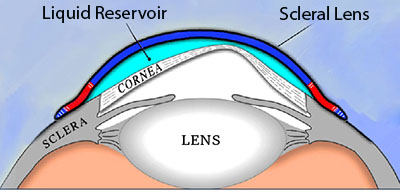 Justin is a patient with Keratoconus and has been wearing Corneal RGP Lenses for the past seven years. Although his vision had been stable, the RGP lenses created problem for his active lifestyle. Justin enjoys playing tennis, running, and swimming but the RGP lenses constantly fell out during sports. He often felt irritation from the lenses and thought he had to endure the discomfort from wearing them. Fortunately, all these changed when Justin learned about scleral lenses.
Justin is a patient with Keratoconus and has been wearing Corneal RGP Lenses for the past seven years. Although his vision had been stable, the RGP lenses created problem for his active lifestyle. Justin enjoys playing tennis, running, and swimming but the RGP lenses constantly fell out during sports. He often felt irritation from the lenses and thought he had to endure the discomfort from wearing them. Fortunately, all these changed when Justin learned about scleral lenses.
Scleral Lenses: a great news for patients with Keratoconus
Different from the Corneal RGP Lenses mounted on the cornea; Scleral Lens is not just another form of RGP lenses. The larger diameter of the Scleral Lens allows it to be completely mounted on the sclera across the bulbous conjunctiva. As the result of such design, there is no contact with the cornea and the corneal sclera margin; a gap is formed between the lens and the cornea and the corneal sclera margin. By filling this gap with preservative-free saline, an almost sealed pool of liquid is created between the anterior surface of the cornea and the posterior surface of the scleral lens.
For patients with corneal disease, the fluid can not only create an artificial regular corneal surface, thus restore / improve vision, but also provides a fluid reservoir that bathes the cornea and protects it from the outside environment. It adds the benefit of treating dry eye syndrome caused by conditions such as Sjogren's syndrome, graft-versus-host disease (GVHD) and Stevens-Johnson syndrome.
Whether it is the issue of a primary irregular cornea, such as Keratoconus, pellucid marginal degeneration,or a secondary irregular cornea from corneal trauma, or post radial keratotomy, or laser surgery, Scleral Lenses can be used to correct vision and protect the ocular surface.
What are the advantages of scleral lens over corneal RGP
5 key benefits of Scleral Lenses over Corneal RGP Lenses
1. Scleral Lenses do not come into contact with the cornea and therefore produce practically no foreign body sensation; making them easy to adapt to. On the other hand, corneal RGP lenses are fitted on the cornea, which is made of sensitive tissue, meaning most people need longer time to adapt.
2. Scleral Lenses are safer for sports because scleral lenses have practically no movements on the Eye; while as RGP lenses are mounted on the cornea, they can easily be blinked out during sports activities.
3. RGP Lenses are associated with corneal scarring. On contrast to RGP, Scleral lenses do not touch the corneal surface, the likelihood of corneal damage due to the lenses is greatly reduced.
4. Scleral Lenses can be used not only to correct vision but also protect, heal and hydrate the ocular surface. Such application includes chemical injury, corneal erosion, cornea scarring, severe dry eyes.
5. Scleral Lenses require personalised design and production. Although the initial cost could be high, however, as they can last up to 3 years, they are more cost-effective in the long term.
If you are currently wearing Corneal RGP Lenses but have not achieved your desired vision outcome, or you are like Justin experiencing the discomfort or other problems from the RGP lenses, maybe it is time to consider Scleral Lenses. Optimally fitted scleral lenses can be life changing for many patients.
Copyright © Myopia Control Centre | Ortho-K Melbourne. All rights reserved